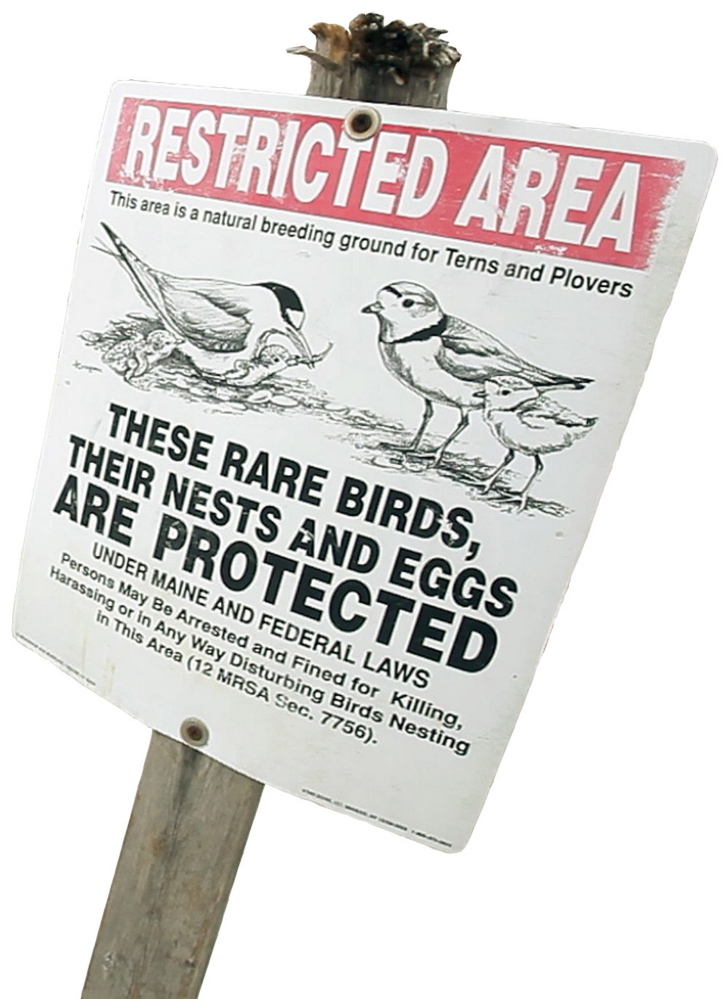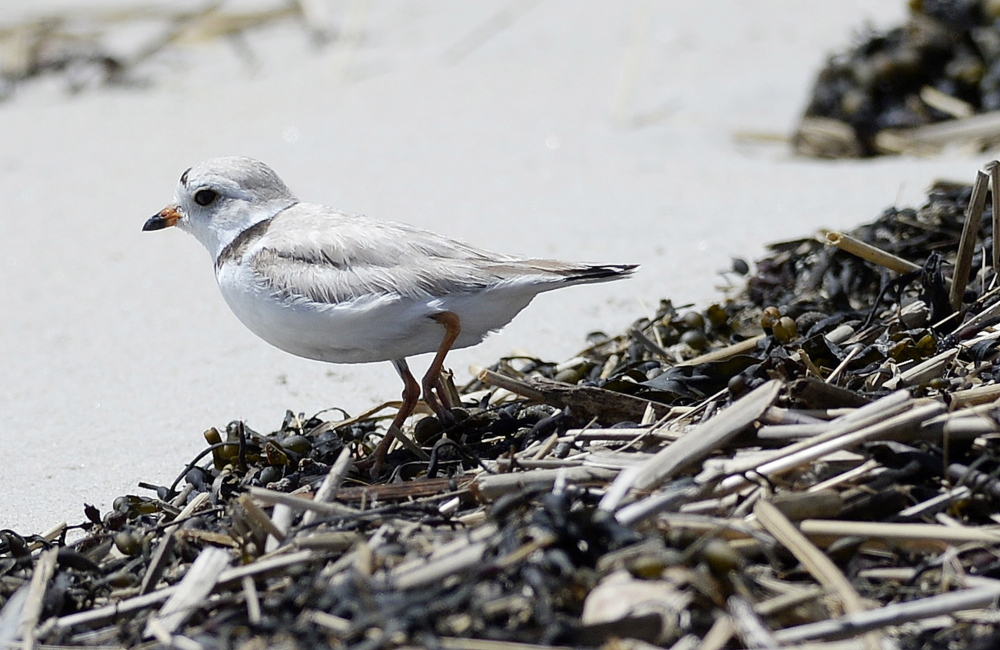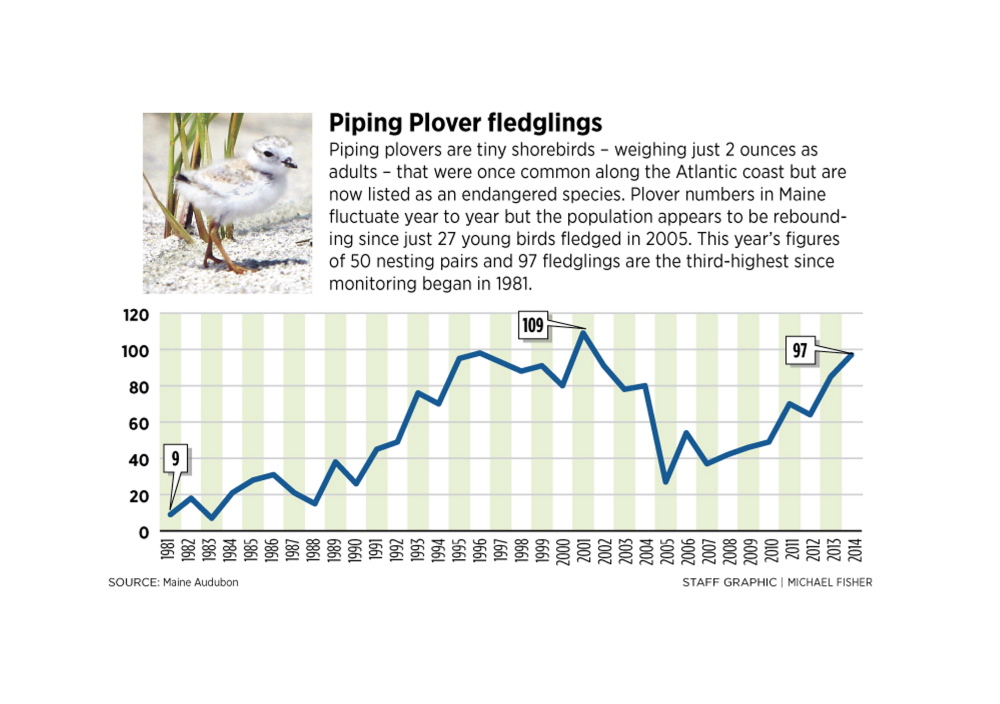Nearly 100 endangered piping plover chicks hatched and took flight on Maine beaches in 2014, more than any other year during the past decade, despite threats from dogs, predatory wildlife and hordes of sunbathers who share plover habitat.
Biologists said 97 chicks fledged – or developed enough to fly – in 2014, up from 85 fledglings last year. The 2014 total is the third-highest since plover monitoring began on Maine beaches more than three decades ago.
The state has seen a gradual, if uneven, increase since the low point in 2005, when barely two dozen plover chicks survived long enough to fledge. That prompted stepped-up monitoring and stiffer restrictions on dogs, which can chase or kill the federally protected shorebirds. In most cases in Maine, beaches remain open to the public while plovers are present, but with fenced-off areas to protect nests.
“It was a good year,” said Laura Minich Zitske, wildlife ecologist with Maine Audubon’s Piping Plover and Least Tern Project. “It is never easy having an endangered species nesting on a beach, but this was good and there were a lot of people who helped.”
Just 7 inches tall and weighing a mere 2 ounces fully grown, piping plovers were once common along the Atlantic coastline but have been driven to near extinction by habitat loss and plumage hunters. Today there are fewer than 2,000 breeding pairs of the tiny shorebirds on the Eastern Seaboard, earning them designations as a “threatened” species at the federal level and “endangered” in Maine.
But plovers’ breeding habits – namely, their preference for the same types of sandy beaches beloved by humans during spring and summer – have led to turf wars between beachgoers and wildlife conservationists from North Carolina to Maine. Those tensions came to a head in Scarborough in 2013 when an unleashed dog killed a plover chick, prompting a contentious debate that ended with passage of additional restrictions on dogs on the beach and increased enforcement of previously overlooked rules.
This year, all three chicks that hatched on Scarborough’s Higgins Beach fledged. Pine Point Beach, which was at the center of the dog-walking controversy, produced a record five plover fledglings from three nests.
Scarborough Town Manager Thomas Hall wasn’t ready to declare a correlation between the new ordinances and the birds’ success, but said the high-profile debate over plovers probably increased awareness about the issue. And he was pleased with Scarborough’s first season under the new rules, calling it an “uneventful year” compared with 2013.
Scarborough hired a part-time beach-monitoring coordinator to help organize volunteer monitors as part of an agreement with the U.S. Fish and Wildlife Service after the plover chick’s death in 2013. Those monitors were responsible for educating and advising beachgoers about the rules and the presence of plover nests. The town’s animal control officer issued four tickets for unleashed dogs, some of which had wandered into closed-off plover areas, and talked to “hundreds” of other people, said beach monitoring coordinator Ryan Wynne.
“It seemed to come to a reasonable conclusion,” Wynne said. “Everyone seemed to get used to (the rules) and the contentiousness subsided somewhat.”
The 97 fledglings in Maine this year were reared by 50 nesting pairs of plovers, the most pairs since 2004. That compares with 44 nesting pairs yielding 85 fledged chicks last year and 42 nests producing 64 fledglings in 2012, according to statistics supplied by Maine Audubon, which partners with the Maine Department of Inland Fisheries and Wildlife and the U.S. Fish and Wildlife Service to monitor plover populations annually.
The high-water mark for plovers over the past 34 years of monitoring occurred in 2001, when 55 nesting pairs yielded 109 fledglings. Within four years, however, the number of fledglings had dropped below 30 and wouldn’t climb above 60 again until 2011. Biologists now believe that increased predation from wildlife that often thrives around humans, such as foxes and raccoons, was a significant factor in that dramatic drop-off. Federal wildlife officials have since put in place a controversial predator-control program that kills some predators in order to protect the plovers.
Lindsay Tudor, shorebird biologist for the Department of Inland Fisheries & Wildlife, said she believes predator control made a difference at Popham Beach State Park at the mouth of the Kennebec River in Phippsburg, where all 14 plover chicks fledged this year. Numerous chicks were lost to predators last year without a management program, she said.
“In this case, we are protecting a species that really is on the brink of extinction in this state,” said Tudor, noting that many of the “removed” predators are common or invasive species. “We don’t want to lose piping plovers in this state, so we have to make these hard decisions. And we don’t make them lightly.”
Plovers nest on about two dozen beaches from Ogunquit to Reid State Park in Georgetown, although not all of the beaches are used each year. The state wildlife agency contracts with Maine Audubon to run the plover monitoring program, with volunteer monitors providing much of the on-the-beach work. Seventy-three volunteers logged more than 2,000 hours this past year, Tudor said.
The most successful spots this year in terms of total chicks produced were Popham Beach, beaches in Kennebunk and, in a surprise to biologists, the crowded sands of Old Orchard Beach. The two Old Orchard beaches hosted six nests that produced 10 fledglings – a fact that Maine Audubon’s Zitske said shows that, with careful monitoring, plovers and humans can share the same space.
“The birds settled in early and they made a go of it,” Zitske said. “And they were successful.”
Federal wildlife officials are still compiling plover population data from other states, but preliminary indications are that 2014 “was fairly consistent with recent years, and in line with what we’d expect based off past productivity,” said Meagan Racey, spokeswoman at the U.S. Fish and Wildlife Service in Massachusetts.
“At the state level, we really only saw a bump-up in the number of plovers returning to Maine, Connecticut and North Carolina,” Racey said. “The number of chicks that survived … appears to have been a little better overall. We saw many more chicks survive and fledge in New Jersey in comparison to the last couple years, and productivity also got a good boost in Connecticut. Unfortunately, Hurricane Arthur wiped out remaining nests and chicks in North Carolina, and also hit eastern Canada and some parts of the Cape.”
Send questions/comments to the editors.






Success. Please wait for the page to reload. If the page does not reload within 5 seconds, please refresh the page.
Enter your email and password to access comments.
Hi, to comment on stories you must . This profile is in addition to your subscription and website login.
Already have a commenting profile? .
Invalid username/password.
Please check your email to confirm and complete your registration.
Only subscribers are eligible to post comments. Please subscribe or login first for digital access. Here’s why.
Use the form below to reset your password. When you've submitted your account email, we will send an email with a reset code.